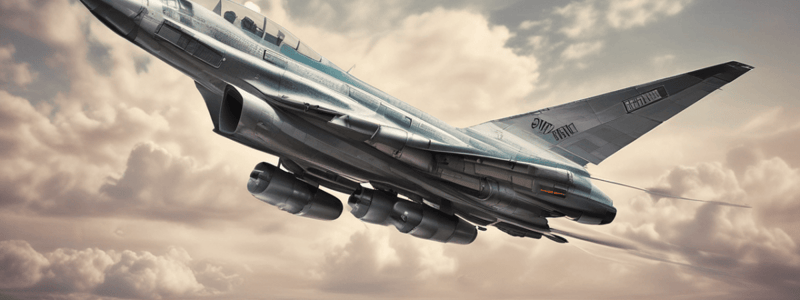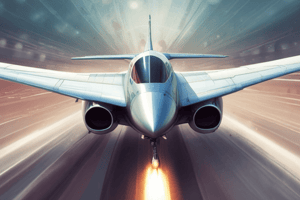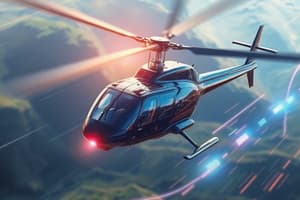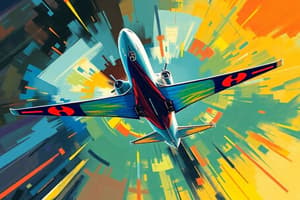Podcast
Questions and Answers
What is the primary factor that determines the center of gravity of an aircraft?
What is the primary factor that determines the center of gravity of an aircraft?
- The shape of the airfoil
- The distribution of mass within the airframe (correct)
- The angle of attack
- The air density
What is the direction of the lift force generated by the movement of air over the aircraft's wings?
What is the direction of the lift force generated by the movement of air over the aircraft's wings?
- Perpendicular to the relative wind and upwards (correct)
- Parallel to the relative wind
- Perpendicular to the relative wind and downwards
- Parallel to the direction of motion
What is the primary component of drag that increases with speed?
What is the primary component of drag that increases with speed?
- Induced drag
- Lift-induced drag
- Air density drag
- Parasite drag (correct)
What happens when the lift force exceeds the weight of the aircraft?
What happens when the lift force exceeds the weight of the aircraft?
What is the purpose of thrust in an aircraft?
What is the purpose of thrust in an aircraft?
What happens when the drag force exceeds the thrust of the aircraft?
What happens when the drag force exceeds the thrust of the aircraft?
What is the primary factor that influences the amount of lift generated by the aircraft's wings?
What is the primary factor that influences the amount of lift generated by the aircraft's wings?
What is the term for the resistance that acts opposite to the direction of motion?
What is the term for the resistance that acts opposite to the direction of motion?
What is the result of a balance between the lift and weight forces?
What is the result of a balance between the lift and weight forces?
What is the purpose of continuously adjusting the thrust of the aircraft?
What is the purpose of continuously adjusting the thrust of the aircraft?
The weight of an aircraft acts through the wingtips.
The weight of an aircraft acts through the wingtips.
Parasite drag is most significant at lower speeds.
Parasite drag is most significant at lower speeds.
The airfoil shape has no effect on the lift generated by the wings.
The airfoil shape has no effect on the lift generated by the wings.
The throttle controls the amount of lift generated by the wings.
The throttle controls the amount of lift generated by the wings.
When the thrust equals the drag, the aircraft will climb.
When the thrust equals the drag, the aircraft will climb.
The angle of attack has no effect on the lift generated by the wings.
The angle of attack has no effect on the lift generated by the wings.
Induced drag is caused by the friction of the air moving over the aircraft's surfaces.
Induced drag is caused by the friction of the air moving over the aircraft's surfaces.
The air density has no effect on the lift generated by the wings.
The air density has no effect on the lift generated by the wings.
The weight of the aircraft is the only force that affects its climb and descent.
The weight of the aircraft is the only force that affects its climb and descent.
Thrust is not required to maintain altitude.
Thrust is not required to maintain altitude.
How does the distribution of mass within the airframe affect the aircraft's center of gravity?
How does the distribution of mass within the airframe affect the aircraft's center of gravity?
What are the primary factors that influence the amount of lift generated by the aircraft's wings?
What are the primary factors that influence the amount of lift generated by the aircraft's wings?
Why is it essential for pilots to recognize the role of gravity in flight?
Why is it essential for pilots to recognize the role of gravity in flight?
What happens when the thrust and drag forces are not balanced?
What happens when the thrust and drag forces are not balanced?
What is the relationship between induced drag and lift?
What is the relationship between induced drag and lift?
Why must pilots continuously adjust the thrust of the aircraft?
Why must pilots continuously adjust the thrust of the aircraft?
What is the result of a balance between the thrust and drag forces?
What is the result of a balance between the thrust and drag forces?
How does the airfoil shape affect the lift generated by the aircraft's wings?
How does the airfoil shape affect the lift generated by the aircraft's wings?
What is the purpose of the throttle in the aircraft?
What is the purpose of the throttle in the aircraft?
Why is understanding the balance of forces essential for controlling the aircraft?
Why is understanding the balance of forces essential for controlling the aircraft?
Flashcards are hidden until you start studying
Study Notes
Gravity's Influence on Flight
- Gravity is a fundamental force that pulls everything towards the Earth's center.
- It determines the amount of thrust needed for takeoff, as the heavier the plane, the more gravity pulls it down.
- Gravity plays a key role in the climb, as pilots adjust engines to produce just enough thrust to overcome gravity while reaching the desired cruising altitude efficiently.
- In level flight, gravity is balanced by the lift produced by the wings, which must be equal to the weight of the aircraft.
- During descent, gravity becomes an ally, helping the aircraft return to the ground, but it must be managed through controlled pitch and engine power.
- Upon landing, gravity ensures the wheels stay on the runway, allowing friction and braking to take over.
Aircraft Design and Gravity
- Aircraft designers compensate for gravity by calculating weight distribution, wing placement, and fuel usage.
- Engineers consider the strength of materials to withstand gravitational forces both on the ground and in the air.
Pilot's Role in Counteracting Gravity
- Pilots must execute maneuvers that account for gravity while keeping passengers comfortable and the aircraft secure.
- Understanding gravity's influence is crucial for pilots to counteract it and make smooth, safe flights.
Thrust and Drag Forces
- Thrust is the force that propels an aircraft forward, created by engines that push the aircraft against the air.
- Drag is a retarding force, the friction that air presents to anything moving through it, and strives to slow the aircraft down.
- There are two main types of drag: parasite drag (impacted by factors such as shape, size, and airspeed) and induced drag (result of lift generation).
Balancing Thrust and Drag
- A steady flight is achieved when thrust and drag are at equilibrium.
- The pilot's role is to manage these forces, throttling up to increase thrust during takeoff or tilting the wings to manipulate drag.
- Changes in thrust directly affect an aircraft's speed and altitude, while changes in drag impact flight performance and fuel efficiency.
The Four Key Forces in Flight
- Lift: a force generated by the movement of air over the aircraft's wings, acting perpendicular to the relative wind and upwards against the weight.
- Weight: a downward force exerted by gravity, acting through the center of gravity of the aircraft.
- Thrust: a forward force produced by the aircraft's engines, needed to overcome resistance and propel the aircraft through the air.
- Drag: an aerodynamic resistance that acts opposite to the direction of motion, consisting of parasite and induced drag.
Balancing Forces in Flight
- For an aircraft to fly level, the lift must equal the weight, and the thrust must equal the drag.
- When these forces are not balanced, the aircraft will accelerate in the direction of the greater force.
- Understanding how to balance these forces is crucial for controlling the aircraft.
Gravity's Influence on Flight
- Gravity is a fundamental force that pulls everything towards the Earth's center.
- It determines the amount of thrust needed for takeoff, as the heavier the plane, the more gravity pulls it down.
- Gravity plays a key role in the climb, as pilots adjust engines to produce just enough thrust to overcome gravity while reaching the desired cruising altitude efficiently.
- In level flight, gravity is balanced by the lift produced by the wings, which must be equal to the weight of the aircraft.
- During descent, gravity becomes an ally, helping the aircraft return to the ground, but it must be managed through controlled pitch and engine power.
- Upon landing, gravity ensures the wheels stay on the runway, allowing friction and braking to take over.
Aircraft Design and Gravity
- Aircraft designers compensate for gravity by calculating weight distribution, wing placement, and fuel usage.
- Engineers consider the strength of materials to withstand gravitational forces both on the ground and in the air.
Pilot's Role in Counteracting Gravity
- Pilots must execute maneuvers that account for gravity while keeping passengers comfortable and the aircraft secure.
- Understanding gravity's influence is crucial for pilots to counteract it and make smooth, safe flights.
Thrust and Drag Forces
- Thrust is the force that propels an aircraft forward, created by engines that push the aircraft against the air.
- Drag is a retarding force, the friction that air presents to anything moving through it, and strives to slow the aircraft down.
- There are two main types of drag: parasite drag (impacted by factors such as shape, size, and airspeed) and induced drag (result of lift generation).
Balancing Thrust and Drag
- A steady flight is achieved when thrust and drag are at equilibrium.
- The pilot's role is to manage these forces, throttling up to increase thrust during takeoff or tilting the wings to manipulate drag.
- Changes in thrust directly affect an aircraft's speed and altitude, while changes in drag impact flight performance and fuel efficiency.
The Four Key Forces in Flight
- Lift: a force generated by the movement of air over the aircraft's wings, acting perpendicular to the relative wind and upwards against the weight.
- Weight: a downward force exerted by gravity, acting through the center of gravity of the aircraft.
- Thrust: a forward force produced by the aircraft's engines, needed to overcome resistance and propel the aircraft through the air.
- Drag: an aerodynamic resistance that acts opposite to the direction of motion, consisting of parasite and induced drag.
Balancing Forces in Flight
- For an aircraft to fly level, the lift must equal the weight, and the thrust must equal the drag.
- When these forces are not balanced, the aircraft will accelerate in the direction of the greater force.
- Understanding how to balance these forces is crucial for controlling the aircraft.
Gravity's Influence on Flight
- Gravity is a fundamental force that pulls everything towards the Earth's center.
- It determines the amount of thrust needed for takeoff, as the heavier the plane, the more gravity pulls it down.
- Gravity plays a key role in the climb, as pilots adjust engines to produce just enough thrust to overcome gravity while reaching the desired cruising altitude efficiently.
- In level flight, gravity is balanced by the lift produced by the wings, which must be equal to the weight of the aircraft.
- During descent, gravity becomes an ally, helping the aircraft return to the ground, but it must be managed through controlled pitch and engine power.
- Upon landing, gravity ensures the wheels stay on the runway, allowing friction and braking to take over.
Aircraft Design and Gravity
- Aircraft designers compensate for gravity by calculating weight distribution, wing placement, and fuel usage.
- Engineers consider the strength of materials to withstand gravitational forces both on the ground and in the air.
Pilot's Role in Counteracting Gravity
- Pilots must execute maneuvers that account for gravity while keeping passengers comfortable and the aircraft secure.
- Understanding gravity's influence is crucial for pilots to counteract it and make smooth, safe flights.
Thrust and Drag Forces
- Thrust is the force that propels an aircraft forward, created by engines that push the aircraft against the air.
- Drag is a retarding force, the friction that air presents to anything moving through it, and strives to slow the aircraft down.
- There are two main types of drag: parasite drag (impacted by factors such as shape, size, and airspeed) and induced drag (result of lift generation).
Balancing Thrust and Drag
- A steady flight is achieved when thrust and drag are at equilibrium.
- The pilot's role is to manage these forces, throttling up to increase thrust during takeoff or tilting the wings to manipulate drag.
- Changes in thrust directly affect an aircraft's speed and altitude, while changes in drag impact flight performance and fuel efficiency.
The Four Key Forces in Flight
- Lift: a force generated by the movement of air over the aircraft's wings, acting perpendicular to the relative wind and upwards against the weight.
- Weight: a downward force exerted by gravity, acting through the center of gravity of the aircraft.
- Thrust: a forward force produced by the aircraft's engines, needed to overcome resistance and propel the aircraft through the air.
- Drag: an aerodynamic resistance that acts opposite to the direction of motion, consisting of parasite and induced drag.
Balancing Forces in Flight
- For an aircraft to fly level, the lift must equal the weight, and the thrust must equal the drag.
- When these forces are not balanced, the aircraft will accelerate in the direction of the greater force.
- Understanding how to balance these forces is crucial for controlling the aircraft.
Studying That Suits You
Use AI to generate personalized quizzes and flashcards to suit your learning preferences.




